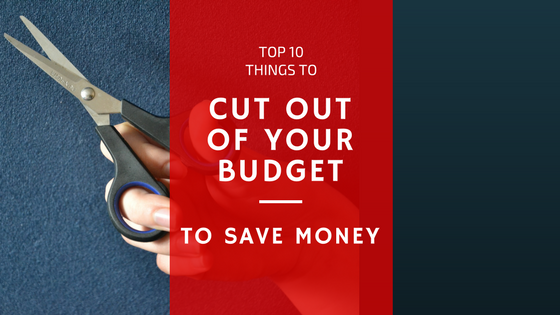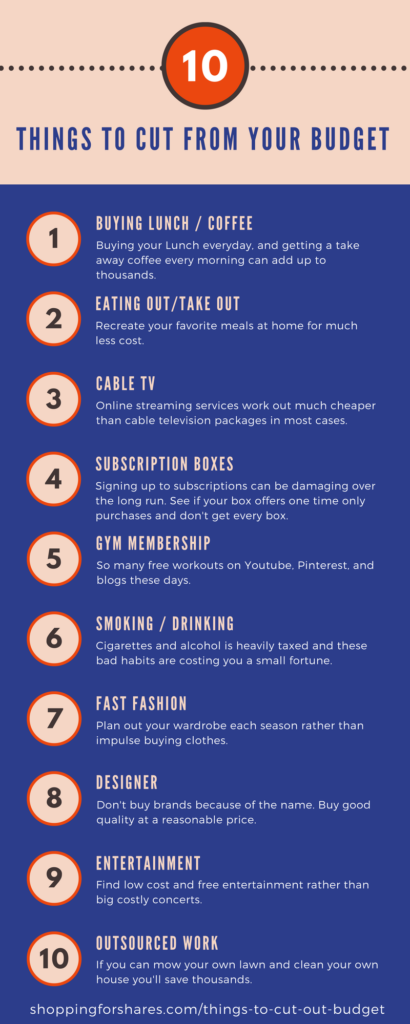If you’re like me, you don’t really think about what things to cut from your budget, you just go along with our normal habits. But once you start looking, it can be amazing what you buy, that you don’t really need.
Every day we make small purchases that don’t seem like a big deal at the time, it’s only five dollars here, ten there. But they can add up to large amounts of money over time eating into our potential to get ahead financially.
The good news is that there are plenty of things to cut out to save money that you might not even miss.

Small changes can have big results. Just like those small purchases can add up to big costs, so can small savings add up to huge savings too. It works both ways.
So let’s get into a few of my favorite things to cut out of your budget that you might not even miss, and that can fast track your savings with that extra money.
But before we get into what you can cut, let’s quickly go over what you can’t.
What can’t you cut from your budget
There are many places in your budget that you can’t cut back on. Things like your rent or mortgage, utility bills, food, and health costs.
While some of those, such as your food and utility costs, can be reduced with careful planning, they can’t be eliminated completely. You need them for everyday living.
This article isn’t going to go into how you can lower your electricity bill or start meal planning (although both are worthy ways of saving extra money), instead, it’ll go over those items that you can easily do without (or find cheaper alternatives for).
Things that you don’t need to spend money on and everything will still be perfectly fine in your life.
So let’s get into it, shall we?
What you CAN cut out of your budget
1) Buying Lunch & Coffee
One of the easiest ways to make a change in those small purchases is by cutting out the coffee that you buy each morning from the local barista or buying your lunch every day at the nearby cafe.
Both of those items you can easily make yourself for much less.
Let’s start with coffee (because all good days/lists should start with coffee, am I right?)
In my area, a cafe bought coffee generally costs between $3 and $5. If you had one coffee per day @ $3, that adds up to $15 a week (5 day work week), and $780 a year. $780 a year just on coffee?!
Compare that if you made it yourself at home: Fancy expresso machine $70, coffee (year’s supply approximate) $150.
Cost to you for one year for making it at home just the way you like it: $220 (and even cheaper the following year since you now have the machine).
Savings: $560
It gets even better when it comes to buying your lunch.
When I worked outside the home, it wasn’t unusual for lunch to cost upward of $10 when you took into account a meal, drink, maybe a snack.
$10 a day equals $50 a week (5 day work week), and $2,600 a year.
You can easily make your own lunch for under $3 at home which includes bringing your own drink.
It can even be ‘free‘ if you use the leftovers from last nights dinner and drink water, but for the sake of this example, I’ll err on the more expensive side and use $3.
$3 x 5 = $15, or $780 a year.
Savings: $1820
Amazing right?!
2) Eating Out/Take Out
Take out and eating out is the second category of things to cut from your budget.
We used to have the habit of getting take away once a week. I didn’t think a lot of it, it was fairly normal to do. It wasn’t unusual to also go out to dinner around once a month.
Until I realized how much it was costing us.
Our regular take out costs for the family averaged out to $30 a meal. Now $30 once a week doesn’t seem like much but over the course of the year, that meant I was spending $1560.
$1560 a year on food that wasn’t even all that good for us.
Now we recreate healthier and much cheaper options at home. Homemade pizza’s with our favorite toppings. Hand cut sweet potato chips with just a dash of olive oil. ‘Fried’ rice with lots of yummy veggies.
Much cheaper AND better for our waistlines.
Savings: $1560
Going to a restaurant is an experience just as much as it is a place to eat. It was rare that we went to a really expensive restaurant, mostly it was your regular run-of-the-mill family restaurants.
Even so, it wasn’t unusual to receive a bill at the end of the night for close to $100 when you took into account food, drinks, desserts, etc.
$100 once a month x 12 months = $1,200.
Now we limit restaurants to special occasions only, like birthdays. I would estimate that we wouldn’t go out to eat more than four times a year now. That means, instead of spending $1,200 a year, it’s more like $400 a year.
Savings: $800
3) Cable TV
It used to be very common here in Australia to have Foxtel, a cable TV subscription package.
It’s less common these days because of the introduction of streaming services such as Netflix and Stan which are way cheaper.
But many people still have Foxtel, mainly because of sport, and because Foxtel is the only way to ‘legally’ watch big shows like Game of Thrones here in Oz.
A subscription to Foxtel can easily run at $80 a month. Even the most basic package is over $50 a month.
It’s likely the same for cable television packages in your neck of the woods.
That is super expensive. We haven’t had Foxtel for over five years now and would have been dumped much earlier if I could have convinced the sport watching male in our household to give it up earlier.
There are alternatives to watching sport (if that’s your reason for still having it). Apps, going to sports bars, going to the actual game. Not as convenient, but paying around $80 a month, is $960 a year.
The alternatives, even attending a live game every few months, is way cheaper.
And if movies and TV shows are your reason for the subscription then buying a season of your favorite show through iTunes, for example, is a lot cheaper than paying for months of cable fees when the show isn’t on.
Cut your cable subscription and find alternatives.
Potential savings: $960
4) Subscription Boxes
The fourth category of things to cut from your budget to save money is subscription boxes.
I used to love subscription boxes.
I still love the idea of them – a box of goodies turning up at your doorstep filled with a bunch of surprise gifts. However, the costs add up fast and I didn’t like how much I was paying each month.
A few years ago we were getting four subscription boxes a month. I was getting two bath and beauty type boxes, one here in Australia, and Fortune Cookie Soap from the US. I was also getting Nerd Block Jr for my daughter and Loot Crate for my son.
If I recall correctly, I was paying around $120 for all the boxes (and shipping to Australia).
They were great boxes and it was fun and exciting to receive them each month. At first.
But then I realized that I was only ever using one or two items out of each box, and it was the same for the kids. They’d like one or two of the toys each month but the rest were discarded or broken or lost.
I canceled all of the boxes and haven’t regretted it. Not even the kids complained.
Saving: $1440
5) Gym Membership
Every year I have lofty ideals of joining the fit crowd on Instagram. I’ll see the perfectly sculpted abs of some Insta model and think, overconfidently, that if I went to the gym I could achieve that.
So I sign up for a three-month contract and go … a lot less than I thought I would. You’re nodding your head right now, aren’t you? You knew that would happen.
I now realize that if I want a flatter stomach it’s not going to happen just by joining a gym. I need to work on it and commit to healthy eating and exercise. The gym is not the magic solution. Commitment and hard work are.
And you can do that at home.
I’m actually more motivated to work out at home where no one can see me than I am going to the gym. I bought a yoga mat and a small set of weights.
I pop on a workout from Youtube and I’ve found a few different instructors that I really enjoy. Plus I can choose the workouts I want. Arms, abs, legs, stretching, yoga, Zumba. Whatever I feel like that day I can find a workout for. For free.
One day I might even get a flat stomach. Maybe.
The gym itself was fine, but the traveling time to get there, the cost, were all an inconvenience. Every time a gym payment would come out of my bank I would wince a bit.
I was paying $35 a week. Ouch. That’s $1820 a year (if I would have stuck it out for a year).
I can go home, get a workout done and shower and have more time for other things.
Costs: Yoga mat $10, weights $30 = $40
Savings: $1780
6) Bad Habits (excessive smoking/drinking etc)
Fortunately, this isn’t something that I’ve had to worry about. I don’t smoke and I’m not a big drinker. But I’ve had friends who are and I’ve seen the damage it’s done to their health and their bank balance.
Working out how much you can save really depends on how many cigarettes you smoke in a day. According to Statista in 2017 the majority of respondents smoked 20 cigarettes a day, which is roughly a packet.
We’ll use the average cost of a pack of cigarettes in Australia (substitute for the costs in your country) and at $20 a pack (cigarettes are taxed heavily here), your smoking habit is costing you $7,300 a year.
Yikes.
If you were able to give it up (and I realize this is hard for most people) you’ll save so much money and improve your health immeasurably.
Savings: $7,300
Alcohol is also another expensive and potentially health-damaging habit that you should look to cut back on.
According to news.com.au, the average adult Aussie knocks back five beers, a bottle of wine, three mixed drinks, and half a cider a week.
I would assume similar stats across other Western countries. Using average prices for alcohol, that equates to around $80 a week.
We value drinking with our friends much higher than building a strong financial future for ourselves and our families.
And look, I’m not going to knock the occasional night out with your friends, it’s a great way to catch up and socialize. But there are plenty of ways to hang out that doesn’t include alcohol every time.
And spending $80 a week equates to $4,160.
If you cut that back to going out fortnightly instead of weekly, you’d save thousands and still wouldn’t feel like you’re missing out.
Saving of cutting alcohol consumption in half: $2,080
7) Fast fashion/clothing
We’ve all bought clothes that we didn’t need but thought would look cute on us.
I’m guilty of this too, especially when it comes to buying for my children. I’ll see a gorgeous dress that would look adorable on my daughter and, look, it’s only $20. And those shoes would match it and what about a hair band and … yep. I’ve just spent $50 on clothes she doesn’t need. She’s already got ten dresses that she barely wears. Half the time she grows out of that size after only wearing the item a few times.
And let’s not get started on how often I wear heels. (hint: never). Why do I own more than one pair?
Buying clothes for yourself and your family on a regular basis, even discounted items, can not only get expensive, it’s time-consuming.
When I shopped that way, it wasn’t unusual to spend $30 to $50 a week per person picking up a few items here and there. Compare a conservative $30 a week ($1560 a year) to buying a few good basics at the start of the season, $150 x 4 times a year ($600) which is the average I spend now per person (usually more summer and winter, less autumn and spring). Note: This doesn’t include school uniforms, just everyday clothing.
Some seasons you might only need to add one or two extra items, other times you might need more.
That planning at the start of each season will save you money and keep you looking stylish because you won’t be buying things on a whim and you’ll get things that work for you.
I’ve learned now that planning out your wardrobe based on your lifestyle and the season, essentially creating a capsule wardrobe for yourself and your children, will go a long way in not only saving all those impulse buys, but you’ll be able to get exactly what you need.
Saving: $960
8) Designer items
I put this one in because I’m constantly amazed at just how much designer clothing and accessories can cost. $200 for one t-shirt that I’ll likely spill spaghetti sauce on anyway? No thanks.
There is an argument that cheaper clothing can be more expensive in the long run because they don’t last as long and you need to replace them more often.
While I do agree that cheaper clothing can become misshapen, fade, or just not hold their style for as long, with the way fashion changes I don’t find this to be a major problem.
Buying an ethically sustainable t-shirt from a reputable buyer costs around $15-$20 and will easily last me a year or more. I’d need that $200 designer tee to last ten years (or more) to save me money and sadly that hasn’t been my experience.
The potential here is to save thousands, but let’s keep it to just this example.
Saving: $180 +
9) Expensive Entertainment
Tickets to see bands, singers, sporting events, etc. Entertainment can get very expensive, very fast. It’s not unusual for the average family to spend $100 a month on entertainment costs.
There are many ways to save money on entertainment costs: attending free events, volunteering at big shows, see if any of your memberships offer discounts on entertainment.
Even smaller entertainment costs such as going to the movies or reading books can be made less expensive by joining a library or waiting until the movie comes out on iTunes and renting it.
Here is how I handle entertainment expenses. I’ll go to Movies or buy books occasionally because I enjoy them, as do my children.
However, we’ll skip the expensive movie shop snacks, or purchase books online at a discount store. As long as it fits into my ‘shopping’ expenses I’m fine with it.
Concerts and shows are another matter. Fortunately, there aren’t many expensive entertainment options that we want to do. Favorite singers don’t come to Australia as often, and we aren’t big theatergoers.
However is there is one big show that I think we’ll enjoy, we’ll maybe indulge once a year. No more, and often much less.
The rest of the time we look for low cost or no cost activities. Parks, visiting friends, going to the beach. Simple pleasures can be just as amazing.
Savings: up to $1200 (based on avg $100 a month entertainment cost)
10) Outsourced Work
Finally my last big way to save lots of money is to stop outsourcing jobs that you’re capable of doing yourself.
I’m not talking about specialized work like electrical or plumbing etc. Unless you know what you’re doing, hire a professional for these.
I mean outsourced work like cleaning your home, mowing your lawn, washing your car. These are all things that you can easily do yourself.
Yeah, some of those jobs are a pain and can suck. They can make you dirty and sweaty and take time. I try and pretend it’s like free exercise. Put in your headphones with either a podcast, an audio book, or Spotify and get to work.
In my area, the costs for mowing a lawn is around $50. Cleaning a home, runs around $30 an hour, and washing your car $10-15 bucks.
The average person would mow their lawn, twice a month. They would get cleaning once a week. And maybe get the car washed two or three times a year. That would add up to $1,200 + $1,560 + $30 = $2,790. That’s more expensive than two gym memberships.
Think of the calories you’ll burn and roll your sleeves up. You can do these jobs.
Saving: $2,790
—
So there you go. My favorite ten things that you can cut out of your budget to save money. Combine a couple of my tips and you could be saving a few thousand dollars a year. Money that you can use to pay off debt, save or invest.
I hope you found this article helpful.
Tracey 🙂
P.S. This article was actually the base script for a Youtube video I filmed this week. Here’s a link to the video.
[Infographic]



